- Karachay folk music
- Special tunes
- The classes of Karachay folk music
- Class 1: Rotating and plagal motion (№ 1−8)
- Class 2: One or two short lines and their variations with x(1)1 cadences (№ 9-37)
- Class 3: Four short lines with (1) main cadence (№ 38-53)
- Class 4: Four short lines with the first line ending on the key note, with a (pseudo) domed structure and 1(x)y cadences (№ 54−62)
- Class 5: Four short lines with (VII) main cadence (№ 63−70)
- Class 6: Four short lines with (2) and (b3) main cadences (№ 71−105)
- Class 7: Four short lines with (4/5) main cadences (№ 106−115)
- Class 8: Four short lines with (4/5) main cadence and a higher beginning (№ 116−138)
- Class 9: Four short lines with (7/8) main cadences (№ 139−145)
- Class 10: One- or two-lined tripodic tunes (№ 146–186)
- Class 11: Tunes with four tripodic lines (№ 187–199)
- Class 12: Jir tunes (№ 200–278)
- Class 13: Four long lines with arched (domed) structure (№ 279–287)
- Connections between Hungarian and Karachay folk music
Class 2: One or two short lines and variants with x(1)1 cadences (№9-37)
Many Karachay tunes comprise one or two short lines and their variants. These variants end on the closing notes of preceding lines, but the tonal range gets ever narrower line by line. In some cases the strophic text arranges them into four-lined stanzas but the descent to the fundamental justifies taking them for one- and two-lined forms.
Since the melody progression is descending or hill-shaped and conjunct, it is sufficient to arrange the tunes by cadences, though sometimes tunes of different tonal ranges may get in the same group in this way.
2.1. There are three tunes of minor (Aeolian-Phrygian-Dorian) character (Ex.2.1a, № 9-10)4 and three mixolydian, in this group of tunes whose every short and very similar line descends to the basic note (Ex.2.1b, № 11-12). Typical are the narrow 1-5 or 1-4 tonal ranges, exceptional being № 12 with its 1-7 ambitus. It is revealing of the structural development of Karachay folk music that surprisingly few such simple tunes can be found, and moreover, the most elementary tunes are often arranged in regular four-lined forms.
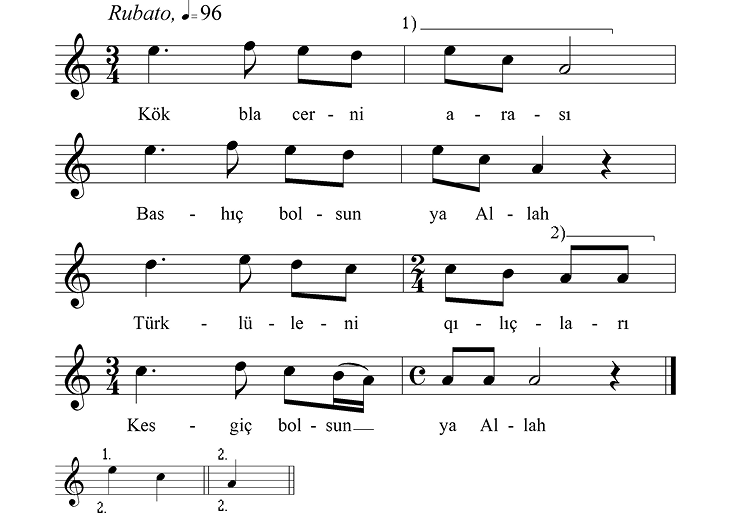
Ex.2.1a. One short line and its variants
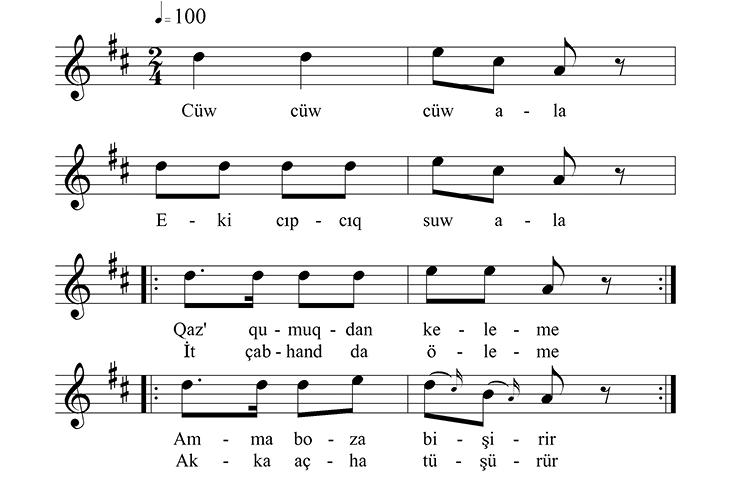
Ex.2.1b. One short line and its variants
2.2. Eight of the tunes comprising two short lines have (2) main cadence, all moving on a scale with the major third, most of them using tones of a narrow range (1-4/5) (Ex.2.2, № 13-19). Some tunes are more or less similar to the small form of Hungarian laments, but in groups 6 and 10.3 closer similarities will be seen. № 15 starts like the rest of the class but descends further along two additional lines. This brings it close structurally to the downward extension of the small form of the Hungarian laments. (More about it see in the chapter on the connections between Hungarian and Karachay folk music.)


Ex.2.2. Two short lines and their variants with (2) cadence: a) Karachay tune and b) its Hungarian analogy (MNT V, No. 41. 269, lines 4-6)
2.3. In this more populous group of Class 2 there are six two-lined tunes of Aeolian-Phrygian character with (b3) main cadence and six similar mixolydian tunes with (3) main cadence (Ex.2.3a, № 20-24, and Ex.2.3b, № 25-29, where the odd-numbered lines of № 27 are concave). The tunes of Aeolian-Phrygian character typically have a tonal range of 1-6, those of mixolydian character are narrower, often only 1-3 or 1-4, and consequently, the tunes of different scales in this group differ from each other more. In Karachay folk music the salient tones – e.g. the line-ending tones – are usually approached descending, which makes the rotating F-E-D-E motion in the first lines of some small-range tunes of mixolydian character rather singular. Another unique feature in this group is the refrain of Ex.2.3b skipping on A-E,. The genres are usually lullaby (böllew), zikir and dance tunes. Similarly to the previous groups of the class, the style of the performance is often tempo giusto.
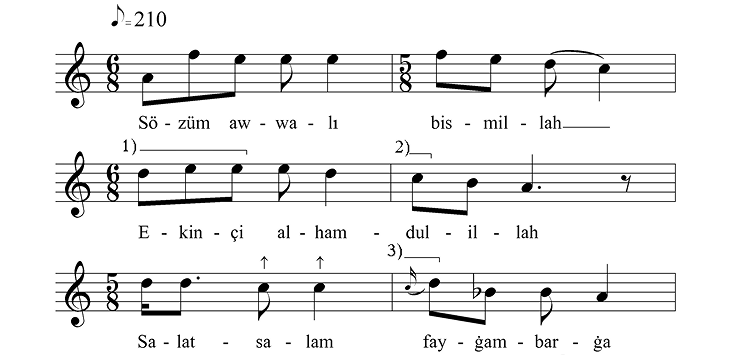

Ex.2.3a. Two short lines and their variants with x(1)a cadences
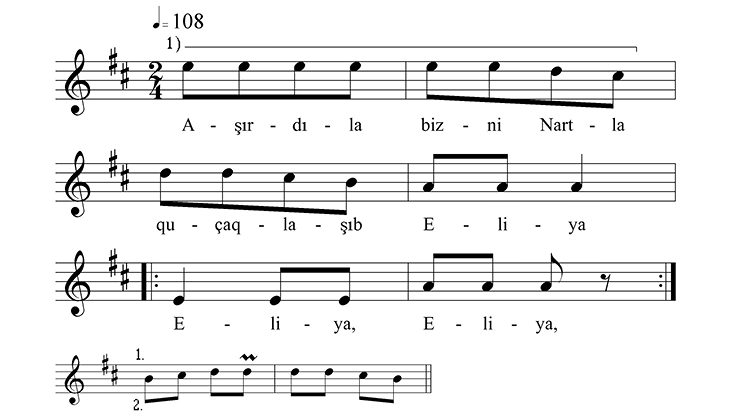
Ex.2.3b. Two short lines and their variants with b3(1)x cadences
2.4. There are relatively few tunes with (4) main cadence, four of which have Aeolian-Phrygian (Ex.2.4a, № 30-32) and three have mixolydian character (Ex.2.4b, № 33-34). The range is usually narrow (1-5) and individual melodic progression is not rare, e.g. № 30 with the rotating E-D-C beginning. They are usually zikir or dance tunes.

Ex.2.4a. Two short lines with (4) main cadence

Ex.2.4b. Two short lines with (4) main cadence
2.5. An even smaller group of mostly Turkish-language tunes consists of four Aeolian-Phrygian zikir tunes with (5) main cadence (Ex.2.5, № 35-37). The 2.5 group already anticipates the next class, but I ranged these melodies here because the second part of the tunes is a refrain that diverges from the first two lines metrically to. The lines usually trace a hill form or descend, and despite the higher main cadence, the range is 1-5/6 and exceptionally 1-7. This is where I present a tune from Otarov’s repertory (№ 37), whose structure and cadences range it here, but its ambitus 1-9 and the rhythmic pattern separate it from the rest of the class. Omar Otarov is a famous Karachay folksong singer, whose repertoire mainly includes atypical, irregular tunes as compared to the 1200 tunes of my collection (Otarov 2001). This fact also underlines the importance of extensive fieldwork in our days, too, if the aim is to get a reliable picture of an ethnicity’s folk music.
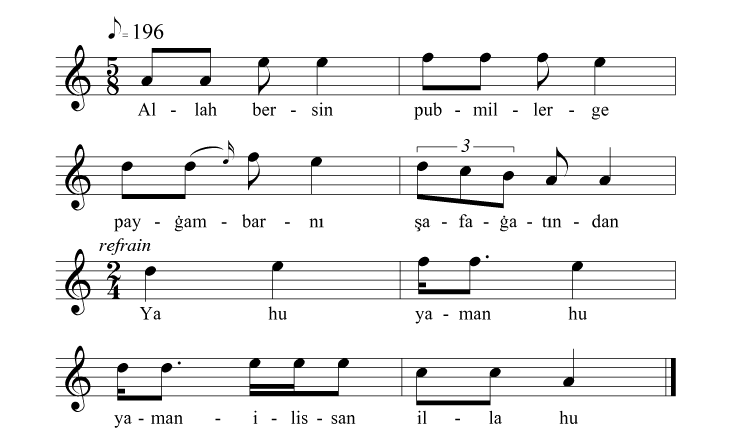
Ex.2.5. Two short lines and their variants with (5) cadence
4 The first line of the refrain of № 10 ends on C.
